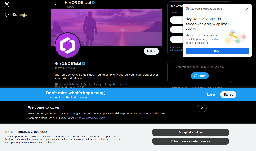I just wanted to take a moment to enjoy how clean the web can be




Actually, with clean sources of electricity like wind and solar, the amount consumption doesn't matter. It only matters if there isn't enough for everyone, or the power comes from non-green sources (coal etc)
I've set my role on my company's slack profile as "code connoisseur"
Your wife leaving you means you're the npc
PLEASE HERE TAKE IT
(Just please stop yelling at me)
Thank you for your sacrifice
Youtube tracks how much of a video each person watches. These metrics are used by youtubers to strike deals with sponsors.
The amount of money the sponsor pays will be based on how many views the sponsor's message part of the video gets.
You're right! There's nothing wrong with efficiency and teaching people to be less wasteful, however I believe including it in your argument for renewables means muddying the message.
Talking about getting production to 100% renewable puts the onus on governments and power companies to change.
Talking about efficiency is about getting consumers to use less, and allows energy producers and politicians to point the finger at people leaving their lights on unnecessarily rather than getting on with the job of making more renewable energy.
This is of course speculation on my part
Could you imagine Microsoft replacing windows engineers with a chat gpt prompt? What would that prompt even look like?
As evidenced by all the prompts, we aren't! But it's still the best place to get the latest info from some companies
Oh I didn't even notice that, now I can't unsee it. Thanks (I hate it), I guess?
You mean the 3.6 roentgen from Chernobyl? And when you say "per day", you mean this measurement implies a period of time?
But it does support usb pd, starting with pi 5, you can use any usb pd power source, so long as it can provide the needed wattage
Nah QA isn't necessarily going to understand code (the best ones do though!)
You...don't believe it works like that? Ultimately a sponsor isn't going to pay much if no one watches the spot. Advertising has always involved getting as much data as possible on how your ads are doing.
I don't have any one definitive link that will tell you "this is how it works", but I've picked up a few things from the various discussions I've seen some youtubers have.
Actually that's not quite how it works from my understanding. Youtube is able to provide detailed metrics that can provide information like "how many people actually watched the sponsor segment?" and base the payouts on that. The payout will either be based on estimated views in advance (meaning if it's lower than expected they'll pay less next time) or they'll pay after the video has been live for some period of time.
The price is more or less the same as it's always been, where is this nonsense 300% coming from? Are you quoting scalper prices as retail?
3.6? Not great, not terrible